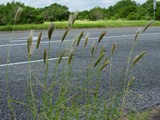Native Plants

Q. Who is Mr. Smarty Plants?
A: There are those who suspect Wildflower Center volunteers are the culpable and capable culprits. Yet, others think staff members play some, albeit small, role. You can torture us with your plant questions, but we will never reveal the Green Guru's secret identity.
Did you know you can access the Native Plant Information Network with your web-enabled smartphone?
Ask Mr. Smarty Plants is a free service provided by the staff and volunteers at the Lady Bird Johnson Wildflower Center.

rate this answer
Tuesday - August 06, 2013
From: Kerrville, TX
Region: Southwest
Topic: Drought Tolerant, Erosion Control, Grasses or Grass-like, Herbs/Forbs, Shrubs
Title: Erosion tolerant plants for shade from Kerrville TX
Answered by: Barbara Medford
QUESTION:
We have just cleared a lot of cedar out of a small draw and would like to know the best groundcovers, shrubs, etc. to plant to hold the soil. Deep shade most of the day.ANSWER:
We just answered a very similar question, with one glaring difference - you are looking for shade plants, which may be a real problem. This time we are going to our full Native Plant Database so we will have more possibilities to choose from. We are in hopes that the draw gets some water from time to time and that will assist us in finding plants for your situation. Please read our similar question first, and then we will go to our database and, using the list of specifications on the right-hand side of the page, select on Texas, then "grass or grass-like" for Habit, "dry" for Soil Moisture and both shade (2 hour or less of sun a day) and "part shade" (2 to 6 hours of sun a day) under Light Requirements. After we run that search, we will run additional searches for the Habits of "shrubs" and "herbs' (herbaceous blooming plants) and see what results we get. We have given you 4 possibillities each for Habit. We suggest, since we really don't know enough about the environment where you propose to grow these plants, that you run the searches for yourself. Each time you select a plant, go to our webpage on that plant, study its light and moisture requirements, then go down the page to Additional Resources. Click on "Find (plant name) in USDA Plants". When you get the map of North America, the green states on that map record that plant as growing natively. Click on Texas and you will get a map with the counties green where that plant grows. This helps us, and we hope it helps you, determine if the soils, climate and rainfall in your area are appropriate to that plant.
Grass or grasslike plants for shade:
Carex planostachys (Cedar sedge)
Chloris virgata (Feather fingergrass)
Melica nitens (Three-flower melic)
Nassella tenuissima (Mexican feathergrass)
Shrubs for Shade:
Acacia angustissima (Prairie acacia)
Aesculus pavia var. pavia (Scarlet buckeye)
Amorpha roemeriana (Roemer's false indigo)
Baccharis neglecta (False willow)
Herbaceous blooming plants for shade:
Ageratina altissima (White snakeroot)
Amblyolepis setigera (Huisache daisy)
From the Image Gallery
More Grasses or Grass-like Questions
Dead, brown Habiturf lawn
July 07, 2015 - I planted Habiturf seeds last fall and had a good lawn all winter. Now the grass is brown and dead. Did it drown with all the rain we have had? If so, what should I do now? If not, what should I do...
view the full question and answer
Curvularia blight in buffalograss in Kansas
March 05, 2009 - Our buffalo grass is infected with a fungus called curvularia. How can we treat it?
view the full question and answer
Is sulfurous well water affecting leaves on trees in Belton TX
November 07, 2011 - We installed an irrigation system for our buffalo grass lawn last spring. The grass is fine but the leaves on the trees are burned where the water hits them. I suspect that the well we are using fo...
view the full question and answer
Sources for native plants from Austin TX
December 19, 2012 - Hello. I am currently planning a Texas native plant garden. Unfortunately, I cannot seem to find the seeds/bulbs/roots/plants for some of the natives at local nurseries: Indian Ricegrass (Achnatherum ...
view the full question and answer
Problems for non-native St. Augustine grass from Little Rock AR
July 18, 2012 - We sodded St. Augustine grass four weeks ago. For the first three weeks we had no rain and temperatures over 100 degrees. We have watered 20 minutes twice a day since installation. There are brown pat...
view the full question and answer
| Support the Wildflower Center by Donating Online or Becoming a Member today. |


